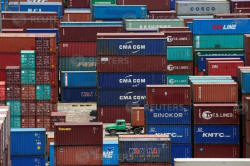OECD trims economic outlook over trade and emerging
market woes
 Send a link to a friend
Send a link to a friend
 [September 20, 2018]
By Leigh Thomas [September 20, 2018]
By Leigh Thomas
PARIS (Reuters) - Global economic growth
has peaked in the face of rising trade frictions and emerging market
turbulence, the OECD said on Thursday, as it trimmed its earlier
outlook.
The world economy is on course for growth of 3.7 percent this year and
next year, up from 3.6 percent last year, said the Organisation for
Economic Co-operation & Development (OECD).
In its previous economic outlook in May, the Paris-based policy forum
had forecast growth of 3.8 percent this year and 3.9 percent in 2019,
but it said in an update on Thursday that growth had peaked since those
last projections were made.
The OECD said trade growth, the engine behind the global upswing in
recent years, had slowed this year to around three percent from five
percent in 2017 as tensions between the United States and its major
trade partners weighed on confidence and investment.

"Export order books have started to decline and that has been going on
for a few months and what that means is the deceleration in trade growth
will continue," OECD chief economist Laurence Boone told journalists.
"We are seeing the rise of protectionism biting into our outlook," she
added.
Even though the United States is the source of these trade frictions,
the economic outlook for the United States was nevertheless the
brightest amongst the OECD's major developed economies, thanks to tax
cuts and government spending.
The OECD left its forecast for U.S. growth this year unchanged at 2.9
percent, but trimmed the forecast for next year to 2.7 percent, from 2.8
percent previously.
[to top of second column] |
 Shipping
containers are seen at a port in Shanghai, China July 10, 2018.
REUTERS/Aly Song/File Photo Shipping
containers are seen at a port in Shanghai, China July 10, 2018.
REUTERS/Aly Song/File Photo

It said that U.S. import tariffs were beginning to have an impact on the world's
biggest economy, estimating that those already imposed would lift overall U.S.
prices 0.3-0.4 percent.
Particular products were even more effected, with U.S. prices for washing
machines jumping 20 percent between March and July while U.S. exports of cars to
China were down nearly 40 percent over one year.
Meanwhile, the OECD said that a weaker currency had so far helped China - which
is not an OECD member - absorb the impact of higher U.S. tariffs, leaving its
growth forecasts unchanged at 6.7 percent for this year and 6.4 percent for next
year.
Rising U.S. interest rates and a stronger U.S. dollar spelled trouble for
emerging market economies such as Argentina, Brazil and Turkey, the OECD said,
slashing its forecasts for those three countries.
Boone said the OECD did not expect the difficulties to become a full blown
emerging market crisis, as had occurred in 1998, because countries managed their
finances better now.
Meanwhile, softer foreign demand meant the euro zone economy was unlikely to
fare as well as previously expected.
The OECD downgraded the euro zone's growth forecast for this year to 2.0 percent
from 2.2 percent, and nudged next year's outlook down to 1.9 percent from 2.1
percent.
(Reporting by Leigh Thomas; Editing by Sudip Kar-Gupta)
[© 2018 Thomson Reuters. All rights
reserved.] Copyright 2018 Reuters. All rights reserved. This material may not be published,
broadcast, rewritten or redistributed.
Thompson Reuters is solely responsible for this content. |